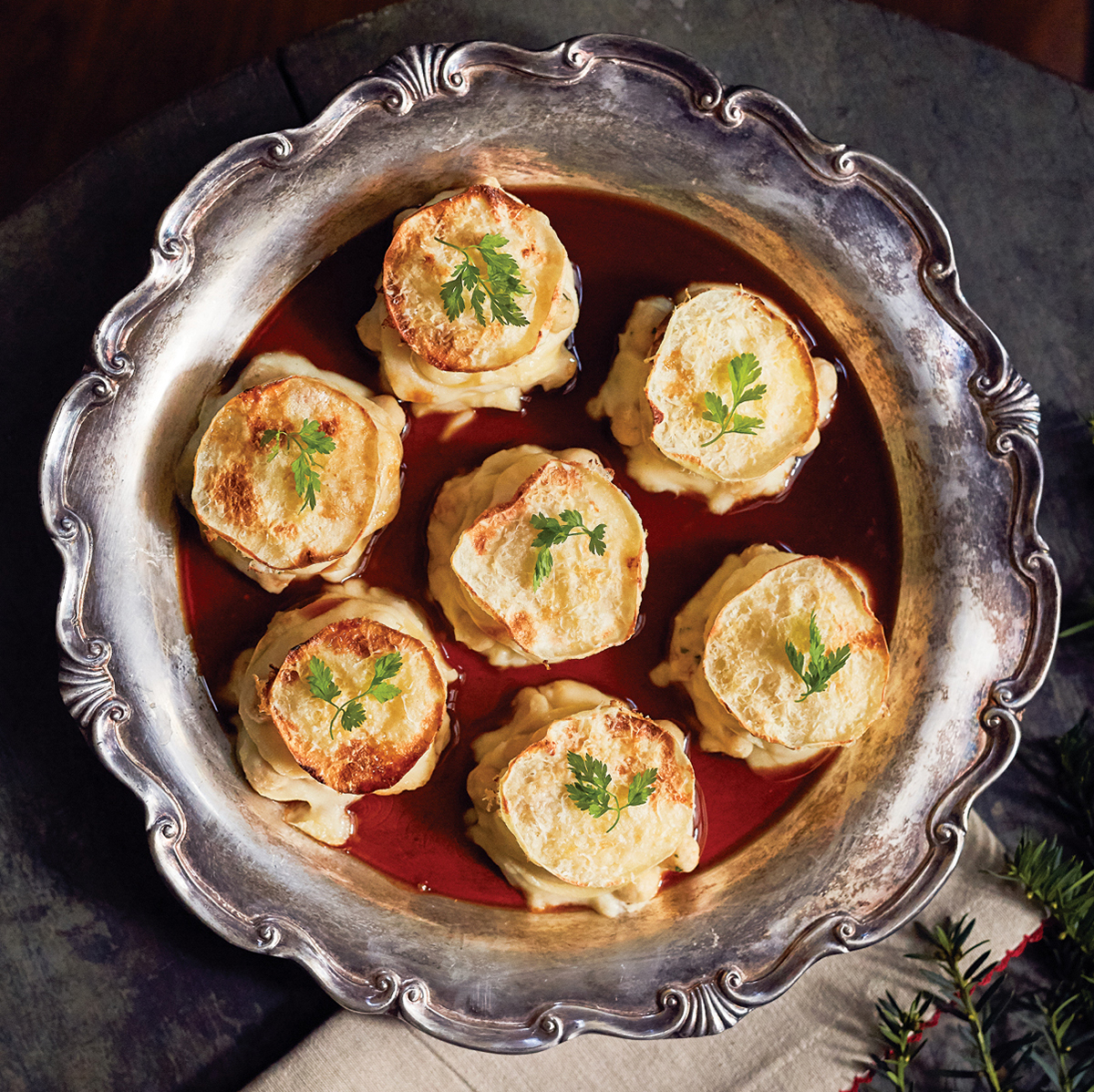Recipe: Pheasant-Meatball Lasagnette

Photograph by Pat Piasecki
Pheasant-Meatball Lasagnette
Adapted from Stir: Mixing It Up in the Italian Tradition
Serves 8
- 4 tbsp. unsalted butter
- ¼ c. all-purpose flour
- ¾ c. milk
- ⅓ c. heavy cream
- ⅓ cup crème fraîche
- ½ lb. fresh pasta dough
- Pheasant meatballs
- Pheasant jus
- Parmigiano-Reggiano for serving
- Kosher salt and freshly ground white pepper
To make the pasta rounds, roll out the fresh pasta dough to the thinnest setting on your pasta machine. Cut the pasta sheets into smaller (8-to-10-inch) lengths to make them more manageable for boiling. Bring a large pot of well-salted water to a boil and position near the stove a large bowl filled with ice water and a good drizzle of olive oil (the olive oil will keep the sheets from sticking together). Cook the pasta sheets until al dente, about three minutes. Gently transfer the sheets to the bowl of ice water to halt the cooking. Once cool, drain the sheets well.
Line a baking sheet with parchment paper and lightly oil it. With a 3-inch round cutter, cut out 40 to 45 circles of dough (you’re making a few extra just in case) and reserve them in a single layer on the prepared baking sheet. (Lynch saves the pasta scraps to cut and add to soup.) If the rounds don’t fit in one layer, oil a piece of parchment paper, put it on top, and start a second layer. If not using the pasta rounds within the next hour or so, top them with a piece of parchment and refrigerate for up to two days.
To make the béchamel, melt the butter in a small saucepan over medium to medium-high heat. Add the flour and cook, whisking constantly, until the mixture (a roux) no longer tastes floury and smells a little nutty but has not darkened, five to eight minutes. Add the milk, heavy cream, and 1 teaspoon of salt and cook for five to seven minutes, whisking until thickened. Take the pan off the heat and whisk in the crème fraîche. Season the mixture (now a béchamel) to taste with additional salt and pepper and pour onto a large plate to cool it quickly.
To assemble the lasagnettes, lay eight rounds of the pasta down on a baking sheet with a little room between each. Top each with about 1 ½ teaspoons of the béchamel and then place 3 meatballs over the béchamel. Continue this layering until you have four layers of the meatballs (you may not need all of the meatballs) and five layers of the rounds.
To serve, heat the oven to 300 degrees Fahrenheit. Add a little (2 to 3 tablespoons) of water to the pan with the lasagnettes and lay a sheet of oiled parchment over them. Bake until heated through, 10 to 15 minutes.
Use a spatula to carefully transfer the lasagnettes to wide bowls or sided plates. Spoon a few tablespoons of pheasant jus around each lasagnette and top with shaved Parmigiano.
Pheasant Meatballs
Yields 100 meatballs
- 1 tbsp. grapeseed oil
- 2 shallots, very finely chopped
- 2 cloves garlic, very finely chopped
- 1 whole pheasant (about 3 lb.)
- 6 tbsp. finely grated Parmigiano-Reggiano
- 1 whole egg, lightly beaten
- 1 tsp. fresh thyme, chopped
- 1 c. homemade bread crumbs or panko
- ½ c. heavy cream
- Kosher salt and freshly ground black pepper
Line a sided baking sheet with parchment paper and heat the oven to 350 degrees Fahrenheit.
Cut the pheasant into pieces. Remove the meat from the legs, thighs, and the breast, discarding all skin and sinew. Save the bones to make the pheasant jus for the lasagnettes. Finely chop or coarsely grind 1 ½ pounds of the meat.
In a small sauté pan, heat the oil over medium heat. Add the shallot and garlic and cook, stirring until very tender but not colored, about eight minutes. Let cool. In a small bowl, pour the cream over the bread crumbs and stir. In a larger bowl, combine the pheasant meat with the cooled shallot, cheese, egg, thyme, 1 tablespoon of salt, and about ¾ teaspoon of pepper. Add the soaked bread crumbs and use your hands to combine everything gently but thoroughly.
At this point, it’s a good idea to take a little of the mixture, flatten it into a patty, and either bake it or sauté it until cooked through. Taste, and add more salt and pepper as needed.
Roll the pheasant mixture into meatballs about ¾ inch around (about the size of a grape); to prevent the meatball mixture from sticking to your hands, keep your hands wet as you roll. Line the meatballs up on the baking sheet without them touching and bake until cooked through, about eight minutes. Cool. If not using within the next hour, cover with plastic wrap and refrigerate.
Make ahead: You can refrigerate cooked meatballs for a couple of days or freeze them for longer storage. To keep the meatballs from clumping together, let them cool and then freeze on the cooled sheet tray until hard before transferring them to a freezer bag.
Pheasant Jus
Yields 2 cups
- ¼ c. grapeseed oil
- Bones from 1 whole pheasant, chopped into 3-inch pieces
- 1 carrot, peeled and chopped
- 1 white onion, chopped
- 1 celery stalk, peeled and chopped
- 1 clove garlic, chopped
- 2 c. dry white wine
- 4 qt. chicken broth, water, or a mix of both
- 1 tbsp. whole coriander seeds
- 1 tbsp. whole black peppercorns
- 2 bay leaves
- 2 sprigs fresh thyme
In a large soup pot, heat the oil over medium-high heat. Add the bones and brown well, stirring them every few minutes for about 15 minutes. Add the carrot, onion, celery, and garlic and cook, stirring occasionally, until they, too, are well browned, about 10 minutes. Pour off any excess oil and fat, add the wine, and cook until the wine has reduced by a little more than half. Add the chicken broth or water, and the coriander, peppercorns, and bay leaves and bring to a gentle boil. Reduce to a lively simmer and cook, occasionally skimming the surface with a ladle, until reduced to about 4 cups; this can take up to two hours, but you can be doing other things during this time. Strain the sauce through a fine-mesh strainer into a smaller saucepan and continue to cook until reduced to about 2 cups. Add the fresh thyme, allowing it to steep for two minutes before removing it. Strain the sauce again if desired and season to taste with salt and pepper.
Make ahead: You can hold the jus for a few days in the refrigerator or freeze it for up to a month.

Photograph by Pat Piasecki
Check out all six Barbara Lynch recipes in our holiday entertaining guide, “A Chef’s Holiday.”

